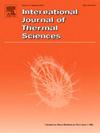An experimental study of flow boiling heat transfer and pressure drop of hydrofluoroolefin and hydrocarbon mixtures in a plate heat exchanger
IF 4.9
2区 工程技术
Q1 ENGINEERING, MECHANICAL
International Journal of Thermal Sciences
Pub Date : 2025-02-11
DOI:10.1016/j.ijthermalsci.2025.109762
引用次数: 0
Abstract
Zeotropic mixture flow boiling in plate heat exchangers is an important heat transfer process that is relevant for a wide range of applications including organic Rankine cycle and heat pump systems, however, the basic theories of the governing heat transfer mechanisms remain poorly understood. This paper presents an experimental investigation of zeotropic mixture flow boiling in a plate heat exchanger, contributing to the state-of-the-art by providing an analysis of the heat transfer and pressure drop characteristics of different types of zeotropic mixtures, the heat transfer degradation of the mixtures, and the influential parameters on heat transfer degradation, as well as an evaluation of the applicability of the current heat transfer and pressure drop predictions methods. For this purpose, two types of zeotropic mixtures, R1234ze(E)/R1233zd(E) and propane/isobutene, were tested at three reduced pressures of 0.45, 0.55 and 0.65, corresponding to the bubble point temperature ranging from 61 °C to 131 °C. The heat flux was varied from 14.2 kW/m2 to 37.6 kW/m2 and mass flux ranged from 52 kg/m2s to 137 kg/m2s. The results indicate that there is a similarity of the heat transfer characteristics between the mixtures and their pure-component fluids, while the two types of mixtures show different heat transfer characteristics due to the differences in their thermo-physical properties. Moreover, the results suggest that the heat transfer degradation of the mixtures with respect to their pure-component fluids can go up to 34 %, with the degradation being largest for working conditions corresponding to weaker heat transfer performance. The evaluated prediction methods are able to provide the good predictions for the zeotropic mixtures, with mean absolute percentage deviations of 9.3 %–11.7 % for the flow boiling heat transfer coefficient predicted by the three prediction methods and a mean absolute percentage deviation of 8.6 % for frictional pressure drop.
求助全文
约1分钟内获得全文
求助全文
来源期刊

International Journal of Thermal Sciences
工程技术-工程:机械
CiteScore
8.10
自引率
11.10%
发文量
531
审稿时长
55 days
期刊介绍:
The International Journal of Thermal Sciences is a journal devoted to the publication of fundamental studies on the physics of transfer processes in general, with an emphasis on thermal aspects and also applied research on various processes, energy systems and the environment. Articles are published in English and French, and are subject to peer review.
The fundamental subjects considered within the scope of the journal are:
* Heat and relevant mass transfer at all scales (nano, micro and macro) and in all types of material (heterogeneous, composites, biological,...) and fluid flow
* Forced, natural or mixed convection in reactive or non-reactive media
* Single or multi–phase fluid flow with or without phase change
* Near–and far–field radiative heat transfer
* Combined modes of heat transfer in complex systems (for example, plasmas, biological, geological,...)
* Multiscale modelling
The applied research topics include:
* Heat exchangers, heat pipes, cooling processes
* Transport phenomena taking place in industrial processes (chemical, food and agricultural, metallurgical, space and aeronautical, automobile industries)
* Nano–and micro–technology for energy, space, biosystems and devices
* Heat transport analysis in advanced systems
* Impact of energy–related processes on environment, and emerging energy systems
The study of thermophysical properties of materials and fluids, thermal measurement techniques, inverse methods, and the developments of experimental methods are within the scope of the International Journal of Thermal Sciences which also covers the modelling, and numerical methods applied to thermal transfer.
 求助内容:
求助内容: 应助结果提醒方式:
应助结果提醒方式:


